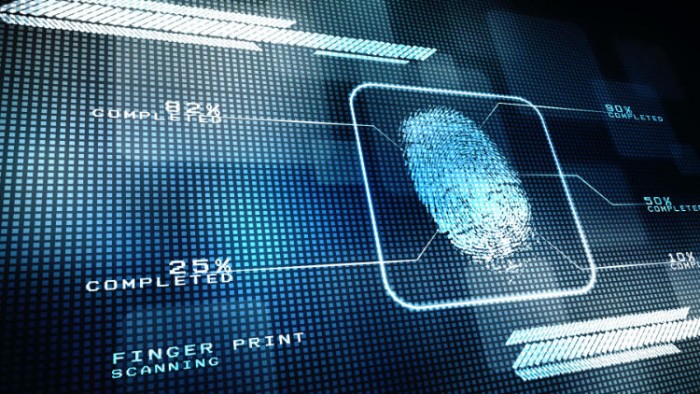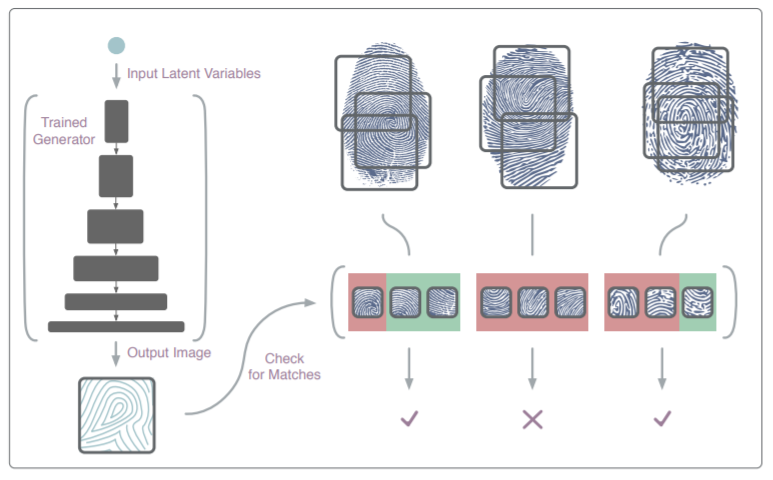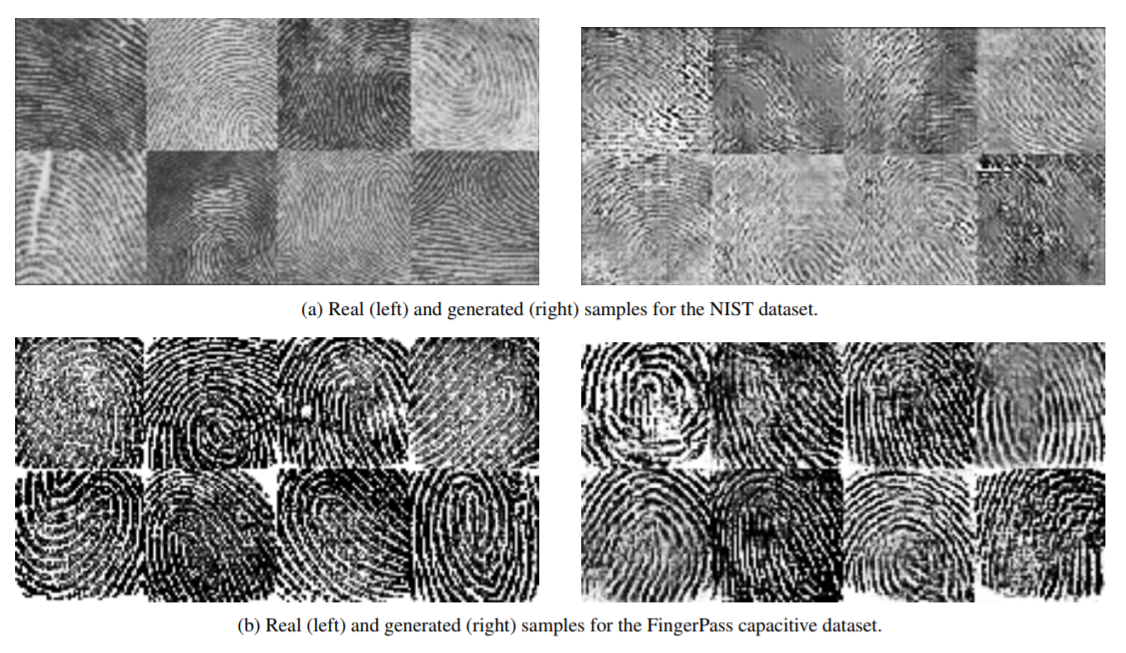

News
Scientists create AI neural net that can unlock digital fingerprint-secured devices
Computer scientists at New York University and Michigan State University have trained an artificial neural network to create fake digital fingerprints that can bypass locks on cell phones. The fakes are called “DeepMasterPrints”, and they present a significant security flaw for any device relying on this type of biometric data authentication. After exploiting the weaknesses inherent in the ergonomic needs of cellular devices, DeepMasterPrints were able to imitate over 70% of the fingerprints in a testing database.
An artificial neural network is a type of artificial intelligence comprising computer algorithms modeled after the human brain’s ability to recognize patterns. The DeepMasterPrints system was trained to analyze sets of fingerprint images and generate a new image based on the features that occurred most frequently. This “skeleton key” could then be used to exploit the way cell phones authenticate user fingerprints.
In cell phones, the necessarily small size of fingerprint readers creates a weakness in the way they verify a print. In general, phone sensors only capture a partial image of a print when a user is attempting to unlock the device, and that piece is then compared to the phone’s authorized print image database. Since a partial print means there are fewer characteristics to distinguish it than a full print, a DeepMasterPrint needs to match fewer features to imitate a fingerprint. It’s worth noting that the concept of exploiting this flaw is not unique to this particular study; however, generating unique images rather than using actual or synthesized images is a new development.

The team involved in the study resulting in the DeepMasterPrint creation initiated it as part of the ongoing assessment of vulnerabilities in fingerprint recognition systems. Finding exploitable flaws and fixing them is a constant battle in all digital systems with a security component. With this reality in mind, the scientists determined that merely exposing the flaws of fingerprint systems would not provide an effective solution; a working example of how attacks could be executed provides more specific data for researchers to design around and protect against. Creating the DeepMasterPrint system was meant to address this need.
The results revealed by the DeepMasterPrint system are concerning for anyone relying on fingerprint authentication on their smartphones. Scientists compared the generated fake prints against templates generated by VeriFinger 9.0 SDK, Bozorth3, and Innovatrics IDKit 5.3 SKD, all of which are software systems used in fingerprint authentication systems worldwide. At a low false match rate, i.e., strict match requirements for authentication, the fake print generated by DeepMasterPrint could imitate 23% of the fingerprints in the test database. At a slightly higher false match rate that was still within standard phone authentication limits, the fake print imitated 77% of the test fingerprints.

The scientists in this study did not create physical fingerprints to try and unlock actual phones, leaving that work to be done in the near future. However, even though the successful DeepMasterPrints have yet to be tested in true applications rather than a virtual environment, the data gathered confirmed the initial security concerns which inspired the experiment. Fingerprints are being used as identity verification in a growing number of applications beyond cell phone security, i.e., unlocking entryways, payment authentication, etc. The DeepMasterPrint system is another tool to help researchers guard their security as biometric authentication continues to expand.

News
Nvidia CEO Jensen Huang explains difference between Tesla FSD and Alpamayo
“Tesla’s FSD stack is completely world-class,” the Nvidia CEO said.

NVIDIA CEO Jensen Huang has offered high praise for Tesla’s Full Self-Driving (FSD) system during a Q&A at CES 2026, calling it “world-class” and “state-of-the-art” in design, training, and performance.
More importantly, he also shared some insights about the key differences between FSD and Nvidia’s recently announced Alpamayo system.
Jensen Huang’s praise for Tesla FSD
Nvidia made headlines at CES following its announcement of Alpamayo, which uses artificial intelligence to accelerate the development of autonomous driving solutions. Due to its focus on AI, many started speculating that Alpamayo would be a direct rival to FSD. This was somewhat addressed by Elon Musk, who predicted that “they will find that it’s easy to get to 99% and then super hard to solve the long tail of the distribution.”
During his Q&A, Nvidia CEO Jensen Huang was asked about the difference between FSD and Alpamayo. His response was extensive:
“Tesla’s FSD stack is completely world-class. They’ve been working on it for quite some time. It’s world-class not only in the number of miles it’s accumulated, but in the way it’s designed, the way they do training, data collection, curation, synthetic data generation, and all of their simulation technologies.
“Of course, the latest generation is end-to-end Full Self-Driving—meaning it’s one large model trained end to end. And so… Elon’s AD system is, in every way, 100% state-of-the-art. I’m really quite impressed by the technology. I have it, and I drive it in our house, and it works incredibly well,” the Nvidia CEO said.
Nvidia’s platform approach vs Tesla’s integration
Huang also stated that Nvidia’s Alpamayo system was built around a fundamentally different philosophy from Tesla’s. Rather than developing self-driving cars itself, Nvidia supplies the full autonomous technology stack for other companies to use.
“Nvidia doesn’t build self-driving cars. We build the full stack so others can,” Huang said, explaining that Nvidia provides separate systems for training, simulation, and in-vehicle computing, all supported by shared software.
He added that customers can adopt as much or as little of the platform as they need, noting that Nvidia works across the industry, including with Tesla on training systems and companies like Waymo, XPeng, and Nuro on vehicle computing.
“So our system is really quite pervasive because we’re a technology platform provider. That’s the primary difference. There’s no question in our mind that, of the billion cars on the road today, in another 10 years’ time, hundreds of millions of them will have great autonomous capability. This is likely one of the largest, fastest-growing technology industries over the next decade.”
He also emphasized Nvidia’s open approach, saying the company open-sources its models and helps partners train their own systems. “We’re not a self-driving car company. We’re enabling the autonomous industry,” Huang said.
Elon Musk
Elon Musk confirms xAI’s purchase of five 380 MW natural gas turbines
The deal, which was confirmed by Musk on X, highlights xAI’s effort to aggressively scale its operations.

xAI, Elon Musk’s artificial intelligence startup, has purchased five additional 380 MW natural gas turbines from South Korea’s Doosan Enerbility to power its growing supercomputer clusters.
The deal, which was confirmed by Musk on X, highlights xAI’s effort to aggressively scale its operations.
xAI’s turbine deal details
News of xAI’s new turbines was shared on social media platform X, with user @SemiAnalysis_ stating that the turbines were produced by South Korea’s Doosan Enerbility. As noted in an Asian Business Daily report, Doosan Enerbility announced last October that it signed a contract to supply two 380 MW gas turbines for a major U.S. tech company. Doosan later noted in December that it secured an order for three more 380 MW gas turbines.
As per the X user, the gas turbines would power an additional 600,000+ GB200 NVL72 equivalent size cluster. This should make xAI’s facilities among the largest in the world. In a reply, Elon Musk confirmed that xAI did purchase the turbines. “True,” Musk wrote in a post on X.
xAI’s ambitions
Recent reports have indicated that xAI closed an upsized $20 billion Series E funding round, exceeding the initial $15 billion target to fuel rapid infrastructure scaling and AI product development. The funding, as per the AI startup, “will accelerate our world-leading infrastructure buildout, enable the rapid development and deployment of transformative AI products.”
The company also teased the rollout of its upcoming frontier AI model. “Looking ahead, Grok 5 is currently in training, and we are focused on launching innovative new consumer and enterprise products that harness the power of Grok, Colossus, and 𝕏 to transform how we live, work, and play,” xAI wrote in a post on its website.
Elon Musk
Elon Musk’s xAI closes upsized $20B Series E funding round
xAI announced the investment round in a post on its official website.

xAI has closed an upsized $20 billion Series E funding round, exceeding the initial $15 billion target to fuel rapid infrastructure scaling and AI product development.
xAI announced the investment round in a post on its official website.
A $20 billion Series E round
As noted by the artificial intelligence startup in its post, the Series E funding round attracted a diverse group of investors, including Valor Equity Partners, Stepstone Group, Fidelity Management & Research Company, Qatar Investment Authority, MGX, and Baron Capital Group, among others.
Strategic partners NVIDIA and Cisco Investments also continued support for building the world’s largest GPU clusters.
As xAI stated, “This financing will accelerate our world-leading infrastructure buildout, enable the rapid development and deployment of transformative AI products reaching billions of users, and fuel groundbreaking research advancing xAI’s core mission: Understanding the Universe.”
xAI’s core mission
Th Series E funding builds on xAI’s previous rounds, powering Grok advancements and massive compute expansions like the Memphis supercluster. The upsized demand reflects growing recognition of xAI’s potential in frontier AI.
xAI also highlighted several of its breakthroughs in 2025, from the buildout of Colossus I and II, which ended with over 1 million H100 GPU equivalents, and the rollout of the Grok 4 Series, Grok Voice, and Grok Imagine, among others. The company also confirmed that work is already underway to train the flagship large language model’s next iteration, Grok 5.
“Looking ahead, Grok 5 is currently in training, and we are focused on launching innovative new consumer and enterprise products that harness the power of Grok, Colossus, and 𝕏 to transform how we live, work, and play,” xAI wrote.








